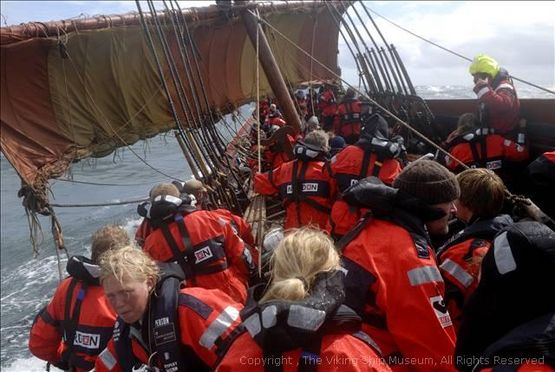Why don’t we navigate as they did in Viking times? Why don’t we wear the clothes the Vikings did? Why don’t we eat the same food as the Vikings did? They didn’t have life jackets in Viking times! Why aren’t we 100% consistent?
The ideal project does not exist, and you can’t have everything. Our finances and our wish for a high level of safety set limits for the options we have for carrying out a voyage that could be compared to the conditions in Viking times in all respects.
We have to prioritise the resources we have available and carry out the voyage on terms that are defensible from the point of view of safety. And our choices obviously have an influence on the research we can carry out and the results we bring home.
For example: How did the Vikings navigate over the North Sea? We have various ideas, but we don’t know precisely how they did it. However, several people have navigated over open sea using methods they thought the Vikings used, and these experiments are very valuable for our research into how the Vikings found their way at sea.
But we chose not to carry out such an experiment. So long as we don’t know more about how Vikings found their way at sea, we don’t think it would be defensible to make such an experiment with a crew of 60. We willingly admit that we don’t have nearly as much experience with these longships as the Vikings did. Our crew includes quite a few square-rig sailors with experience from other Viking reconstructions and especially from traditional Norwegian square-rig boats. But a well-trained and experienced longship crew does not exist (yet…).
Even with modern navigation instruments, weather forecasts and radio contact, the weather can still surprise and force the ship to change course or in to the nearest harbour, so it is good to know where you are. What did the Vikings do? Well, perhaps things didn’t always work out for them…
On this experimental voyage, safety has first priority, so we have personal life-saving equipment in the form of a life jacket, which we always wear, and a wetsuit, which we put on if we get too much wind and rain. We have life rafts and in emergency situations we can also call for help via our modern instruments and give our exact position. Our life-saving equipment takes up so much room that we have no space for the ship’s 60 shields, never mind all the weapons and other equipment the Vikings took on their journeys.
We also chose to limit the voyage to 7 weeks from Roskilde to Dublin and 6 weeks home again. Most of the crew are volunteers. They are spending their holiday and have taken time off work, so they have a limited time for the trip. The fact that the voyage is limited in time means that we can be forced to take a tow to get back on time, instead of stopping and waiting for a favourable wind as the Vikings surely would have done.
And this project is an educational project. The Viking Ship Museum wants to tell people about Skuldelev 2, the “original Sea Stallion”, and what the countryside we sail by looked like in Viking times, etc. We also want to describe the journey, the actual voyage, and we want to do that on-line. A secretariat on board our support vessel, Cable One, makes sure the news comes out. That is why, safety reasons apart, we have a support vessel, which they probably didn’t have in Viking times either.
